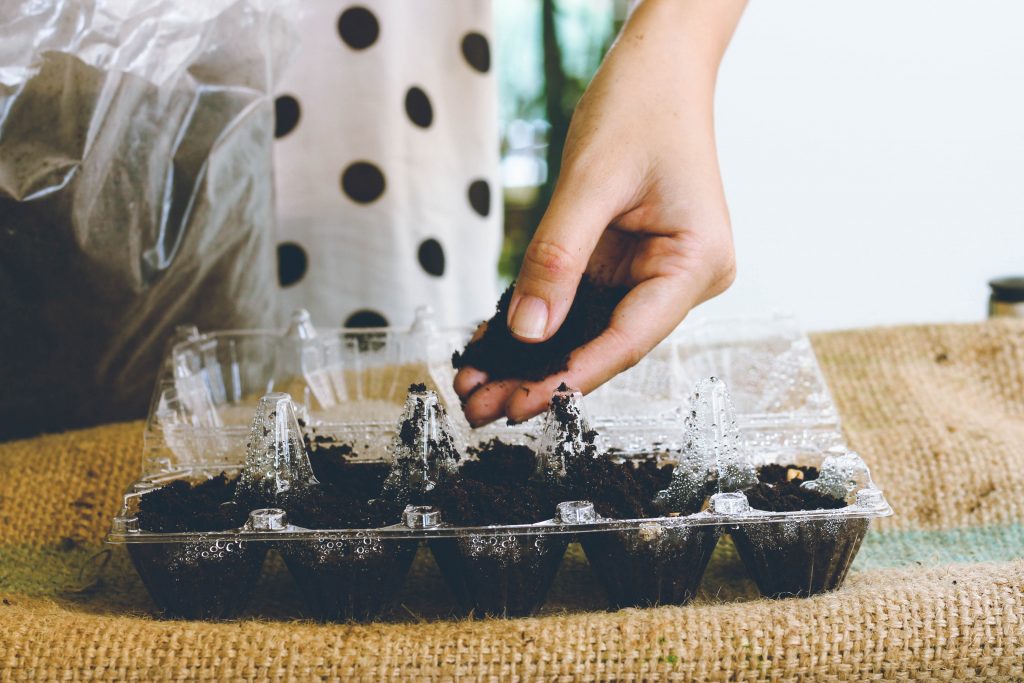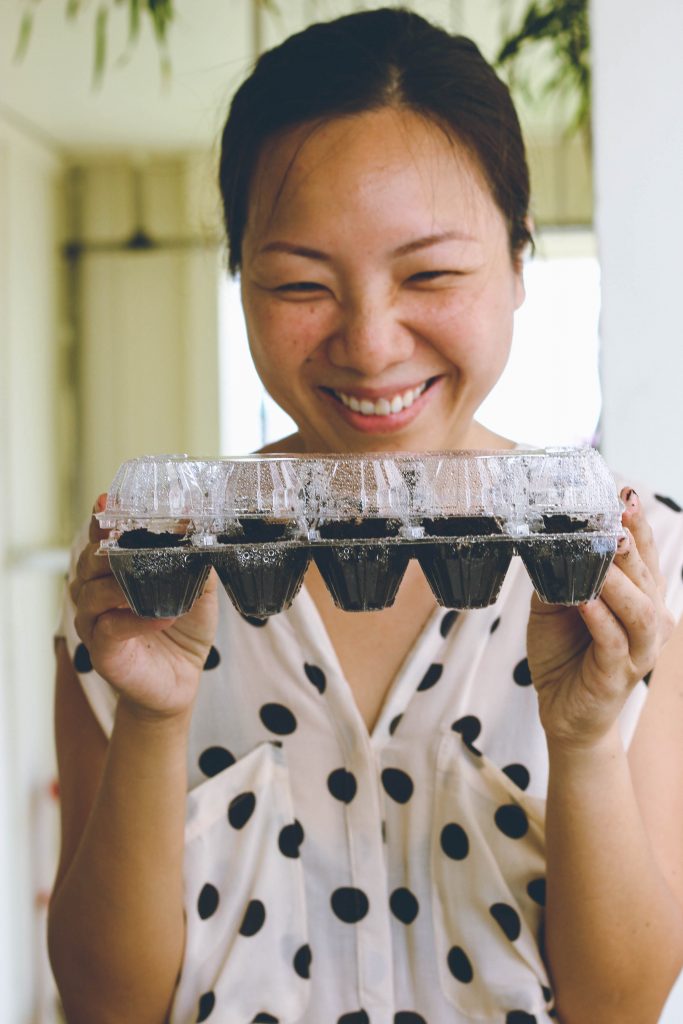
Imagine having a supply of nutritionally dense, fresh sprouts that you can toss into salads, sandwiches, smoothies (or clearly, any other foods that begin with the letter “s“). And it’s all growing right in your own home!
If you’ve been wanting to cultivate your green thumb – you’re going to love this tutorial from Cynthea of Super Farmers. She’ll show you just how easy growing your own food is.
Cynthea is completely self-taught,which you know means she’s had plenty of trials and errors! The story of my life. Ha!
But her happy obsession (you have to see her house – there are sprouts everywhere 🙂 means she’s learned how to make sprouting easy – especially for beginners.

Cynthea has her own stylish aesthetic about it too – sprouting in bowls, mugs and unexpected containers. Nature has become part of her home decor – which gives a fresh feeling to her space!
Whether you live in a big ol house or tiny apartment – you can absolutely have your own little farm. Just imagine how satisfied you’ll feel – from seed to salad. It must be why Cynthea always has a smile on her face! Let’s join her 🙂
How to Sprout Microgreens at Home
tools needed:
- container – more on that below
- seeds – buy good quality seeds from a health food store. Also Cynthea supplies seeds through Super Farmers
- soil – good quality, peat moss soil from a nearby nursery
- time – depending on the seed it can take up to 14 days. Look on the seed packet and it will tell you.
Step 1. Prepare your container
Cynthea explained that we need to make sure the soil has good drainage. So when choosing a container, look for something that you can poke holes into. You can use potting containers – but we like to find ways to repurpose what’s around us!
What container works best? You can repurpose any plastic food container – like egg carton or berry carton from the supermarket. Cardboard does work, but it will start to break down with waterings. In a future tutorial with Cynthea, we can go more into how to sprout in solid containers like ceramic bowls. But, for now, keep it simple and start with a plastic produce or egg container.


Step 2. Add Your Soil
All the pros I speak to agree – that the quality of your plants, depends on your soil! Go for good quality soil that will feed your sprouts and help them thrive. It makes gardening easier on you! Cynthea recommends that you use peat moss. It’s pure, has a good PH and ideal minerals.

once you’ve filled your container – give the soil a good watering until it’s moist to the touch. You’ll then be ready to plant your seeds! I told you it was easy! 🙂

Step 3. Plant Your Seeds
What kind of seeds should you plant? Anything you like to eat! Cynthea says that some of the easier sprouts to grow are: snow pea shoot, sunflower shoots, radish microgreens, greens like bak choy, chinese kale (Kai lan) and basil microgreens. You have plenty of options!
Sprinkle the seeds over the soil. If they are big like these snow peas, spacing them out evenly with a bit more room.


Step 4. Cover them Up
Give your seeds a nice cozy blanket, with a light covering of soil. You want to make sure they’re not exposed, but don’t bury them – about 1 cm of soil will do. Then give them another good watering and you’re done!

If you’re using something with a lid, you can even cover them until they begin to sprout and break through the soil. At that point, you can use the lid as a tray, underneath the container.

In about 14 days, this egg carton will be bursting with snow pea shoots, which Cynthea will happily enjoy! Soon, that will be you!
Common Questions on Sprouting:
How often do you water your sprouts?
Give them a sprinkling of water everyday. You don’t want to saturate them, but make sure the soil is always maintained moist. Don’t pour too hard, you don’t want the water to disrupt the soil and expose the seed.
PRO TIP: Cynthea repurposes a plastic water bottle and pokes holes through the cap to squeeze out a light, even watering.
When can you harvest them?
It depends on what you’ve planted – the seed packet should tell you. It’s usually up to 14 days, or when the sprouts reach 2-3 inches tall.
Will they grow again?
No. Once you harvest them, it’s time to start the process again.
Personally, I think it’s a little easier this way. Your goal is not to keep this plant alive… forever! Sprouting is a low-fuss situation – with a clear beginning and end.
PRO TIP: You can reuse the same soil 2-3 times to sprout new seeds. Pick out the roots and refresh with a bit of new soil. You’re ready to replant again!
What do you think – will you give it a try? It’s too easy not to and it’s such a beautiful project to have in your home. I think that you’ll feel so proud of yourself when you harvest your first crop and enjoy the best tasting sprout you’ve ever had!!
I’m so happy to have a friend like Cynthea to teach me cool things – and now you do too! Check out her workshops or website, Super Farmers – and begin your journey into sprouting!


8 responses to “Learn // How to Sprout Microgreens at Home”
Hello,
this email message is for cynthia the sprouter, please forward, thanks!
Hi Cynthia,
love the step by step demo, you show that its so easy to sprout healthy greenfood!
1 feedback:
The kind of peat moss that originates from temperate peat swamps is usually harvested unsustainably. This potting material is dug out of temperate peat swamps and boglands and in the process, destroys highly fragile and unique peat swamp ecosystems which are homes to wildlife that only can live in this kind of habitat.
The other negative thing is that collecting peat will cause the release of global warming gases such as methane and carbon dioxide which peat swamps trap and store in the ground.
So if we use peat, it should be from a sustainable source (explained on the packaging) or ideally we can use a more sustainable substitute.
BTW peat by itself is acidic, not PH neutral.
Loacl organic farm Quan Fa produces and sells organic compost-based soil
(but I find this too powdery so I mix in sand and other composts to make it less so).
Another company called Greenback also has compost-based soils from recycled bark and tree clippings, although this will not be 100% organic.
But at least its recycled materials and not from peat swamps.
Maybe you can try using these soils instead and produce organic sprouts to eat.
Most commercially available packet soils contain many kinds of poisonous chemicals such as fungicides, fertilisers and pesticides. And some are labelled and some are not.
Happy sprouting!
Cheers, andrew
Hi Militza,
Loved this post! What a fantastic idea to get our daily greens!
Was wondering if you know where I could get my hands on some sprouting/microgreens seeds?
Cheers,
Cherie
Hi Cherie,
Are you in Singapore? Check out: howtobecomeamorningperson.com
cheers! Militza
What happen to the soil after planting for 3 times. Must we throw the soil away or just add in more new soil?
Hi! Thanks for your question – here’s what Cynthea had to say:
After each use, turn the soil and either add new soil or throw in some soil nutrients that contain NPK. These are readily available in nurseries or you can buy it through my website! http://Www.super-farmers.com
I wanna give a thank you to the commenter who was encouraging awareness to where our products come from, and what entities we’re Supporting when partaking of whatever your products are.Thank you.:)
My bad, I just read that she mentioned the same in her summary of getting away. Lol
[…] Parks Board (2010) Pea Shoots: Easy to Grow, and Tasty Too in My Green Space retrieved 8 April […]